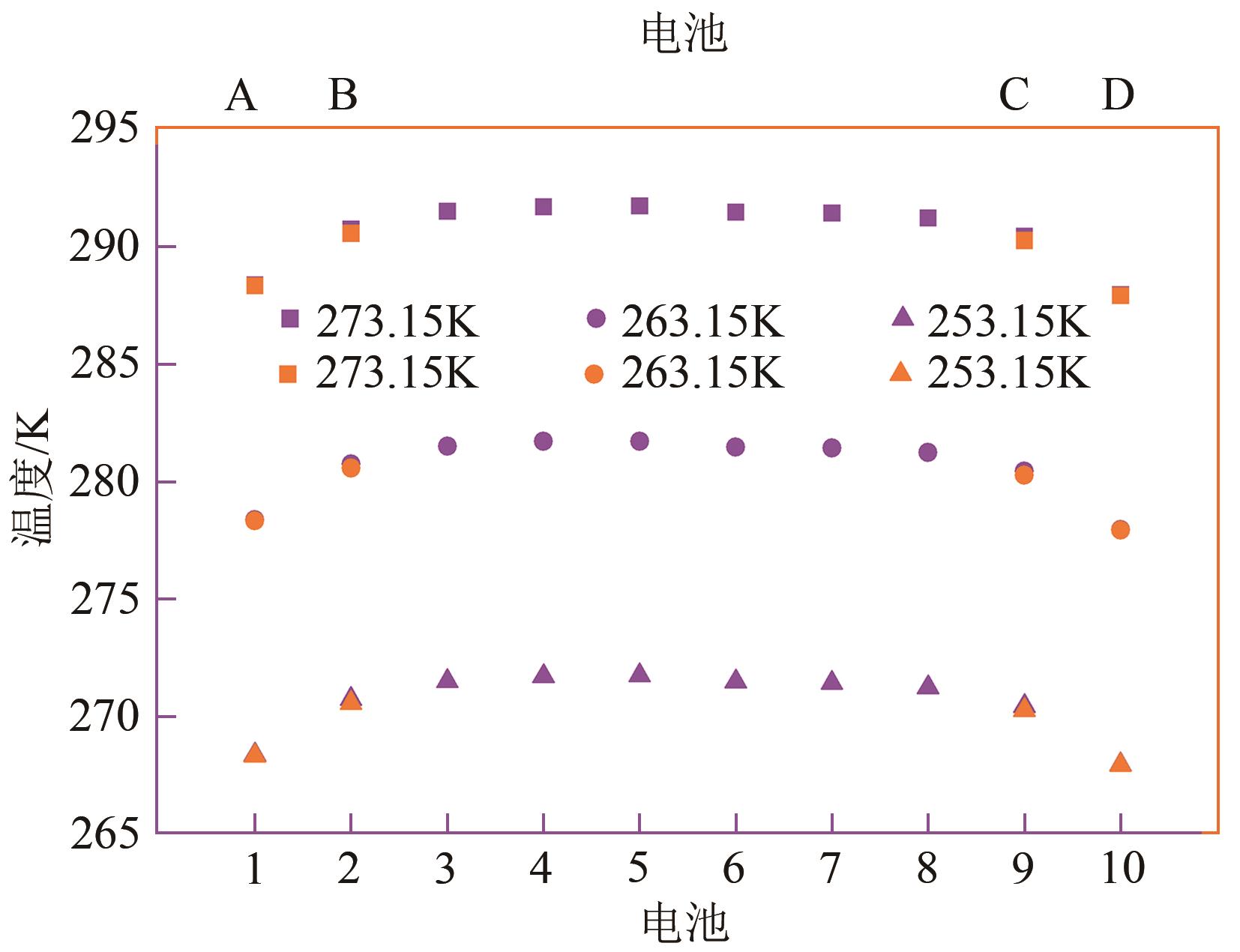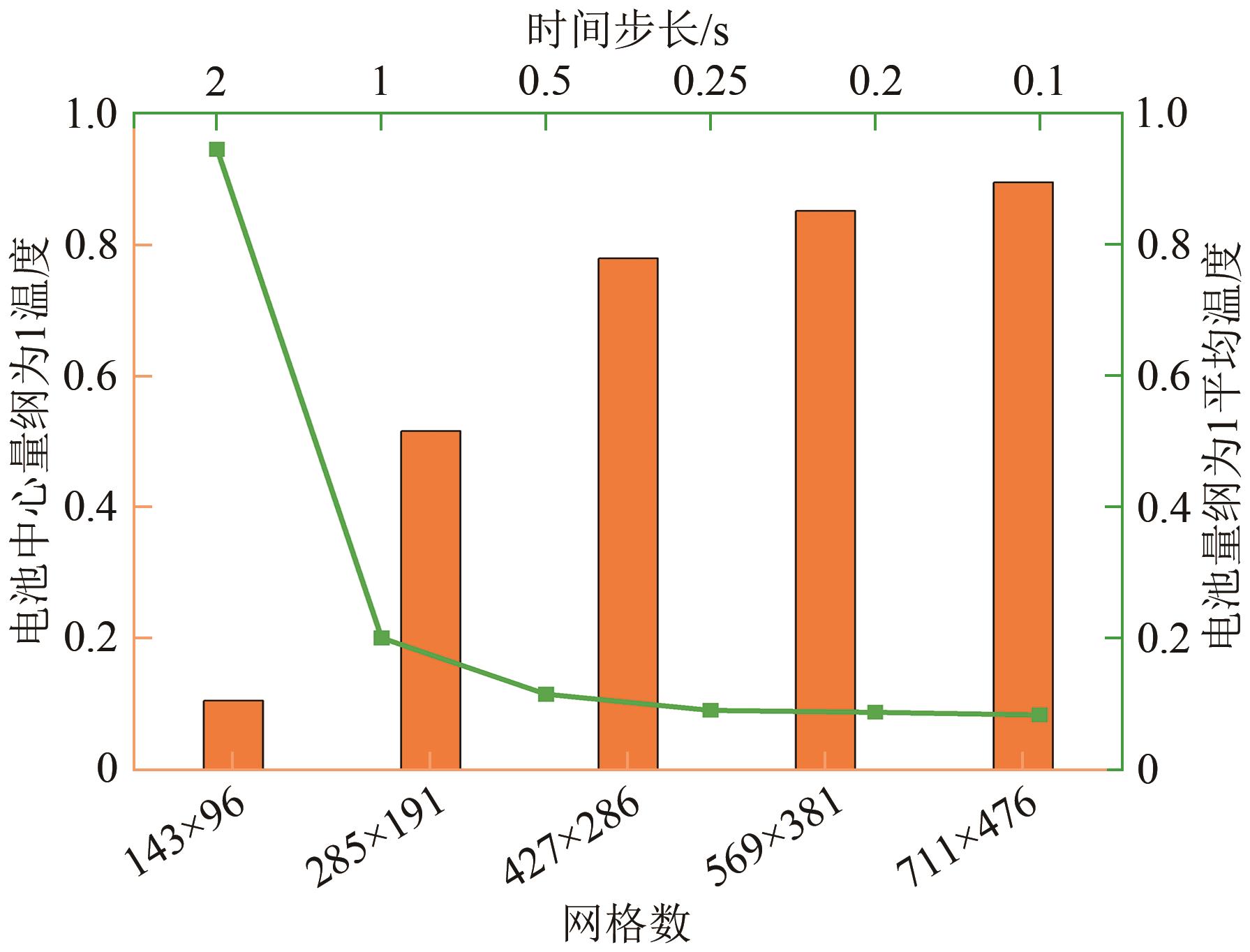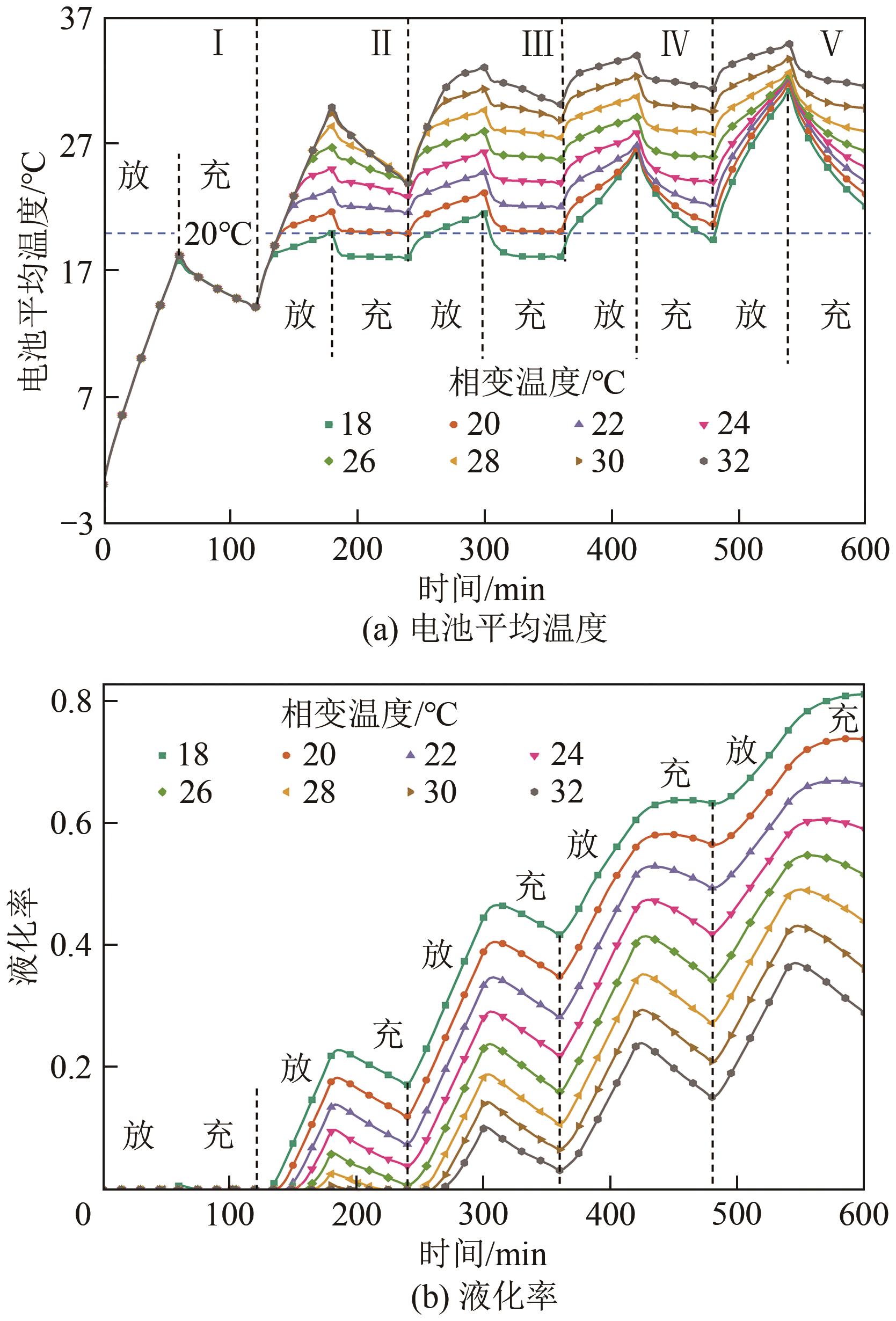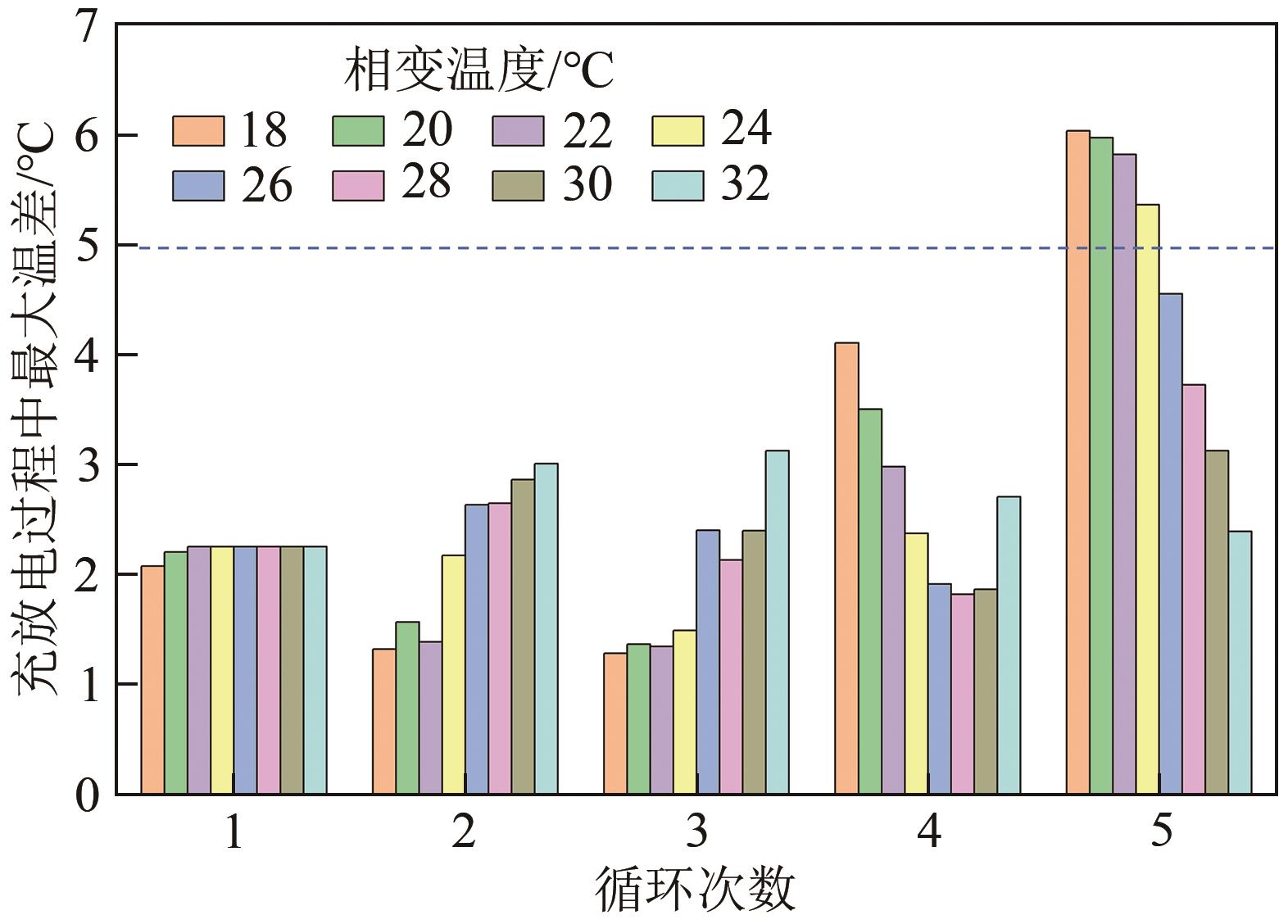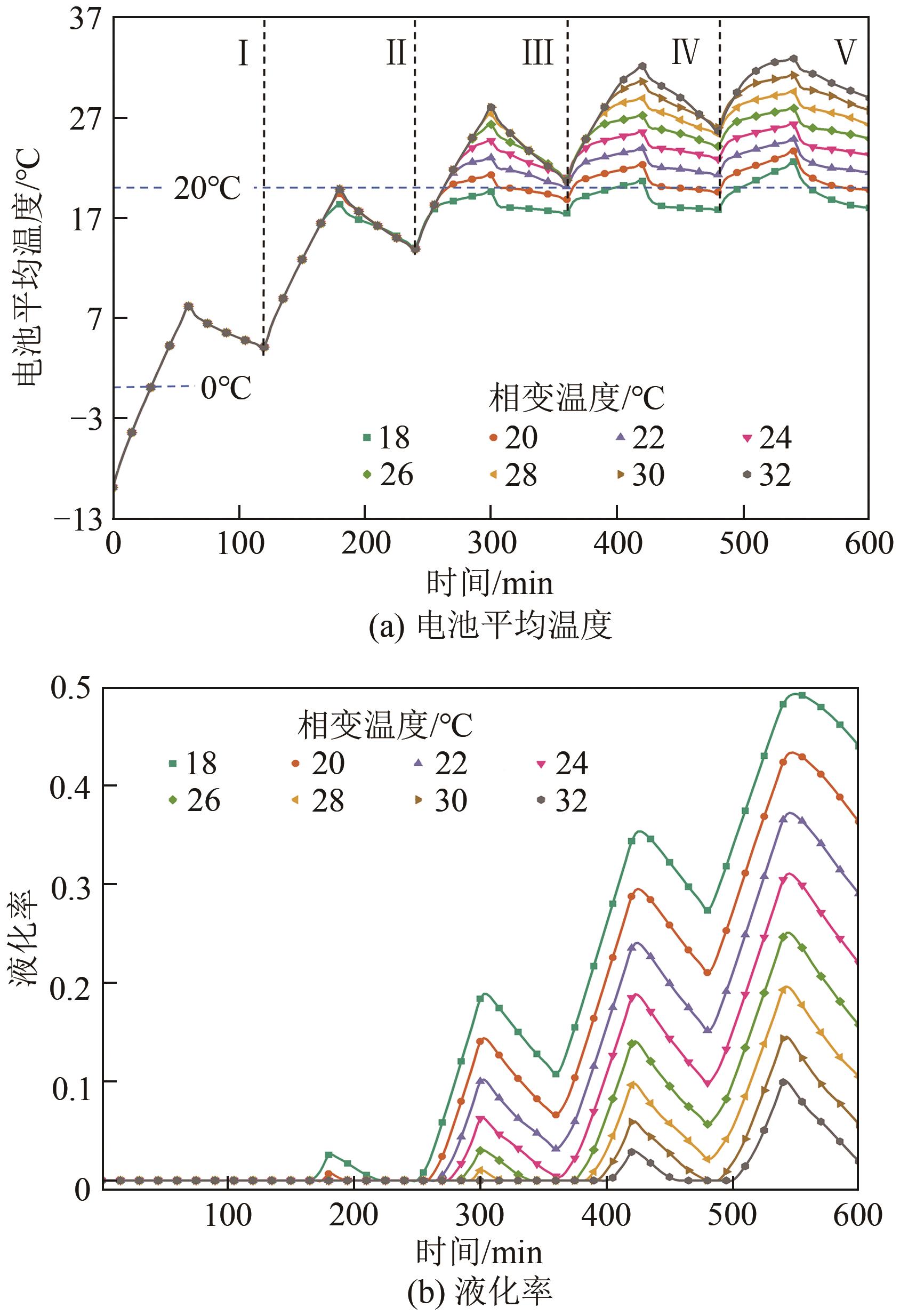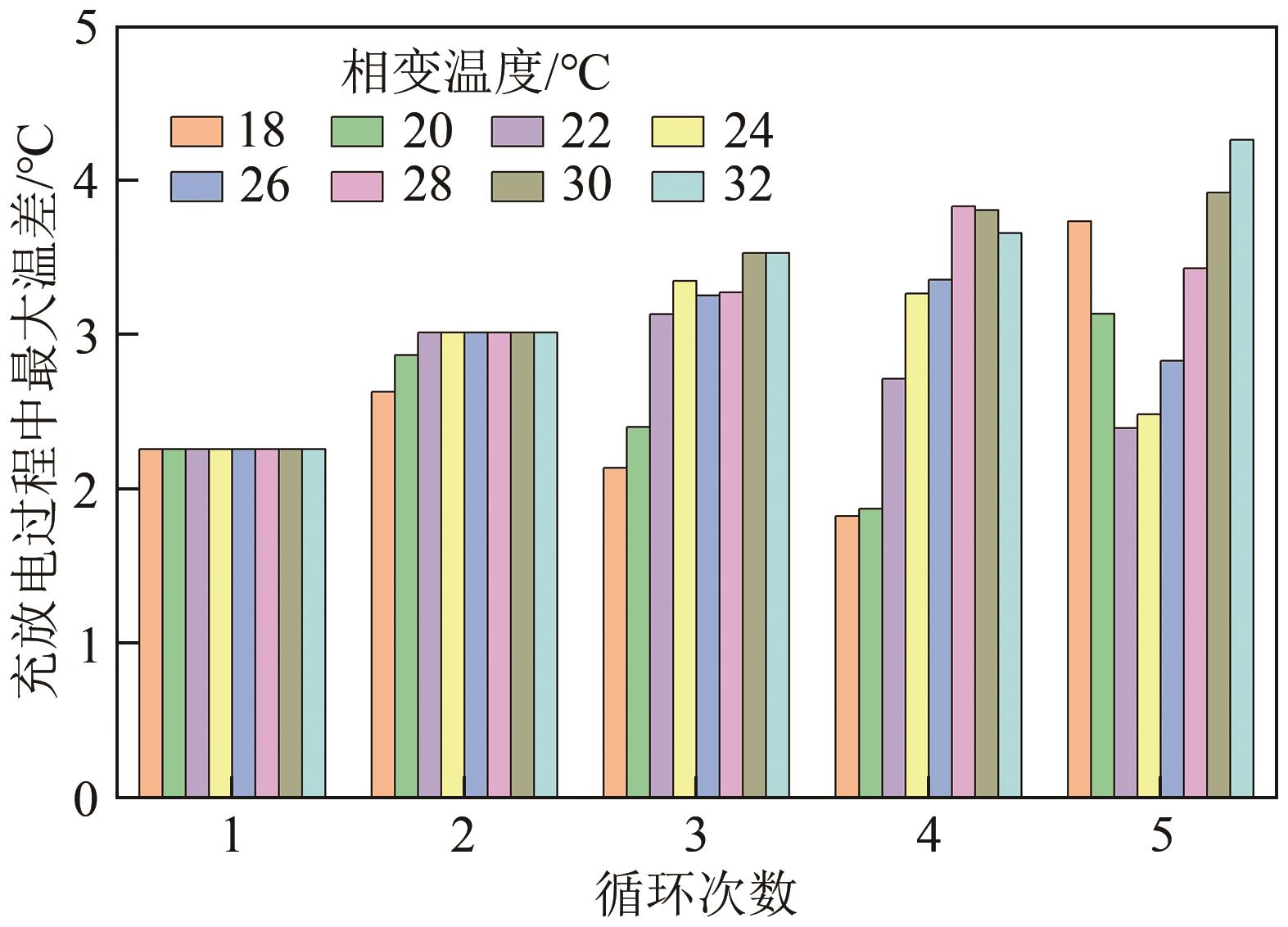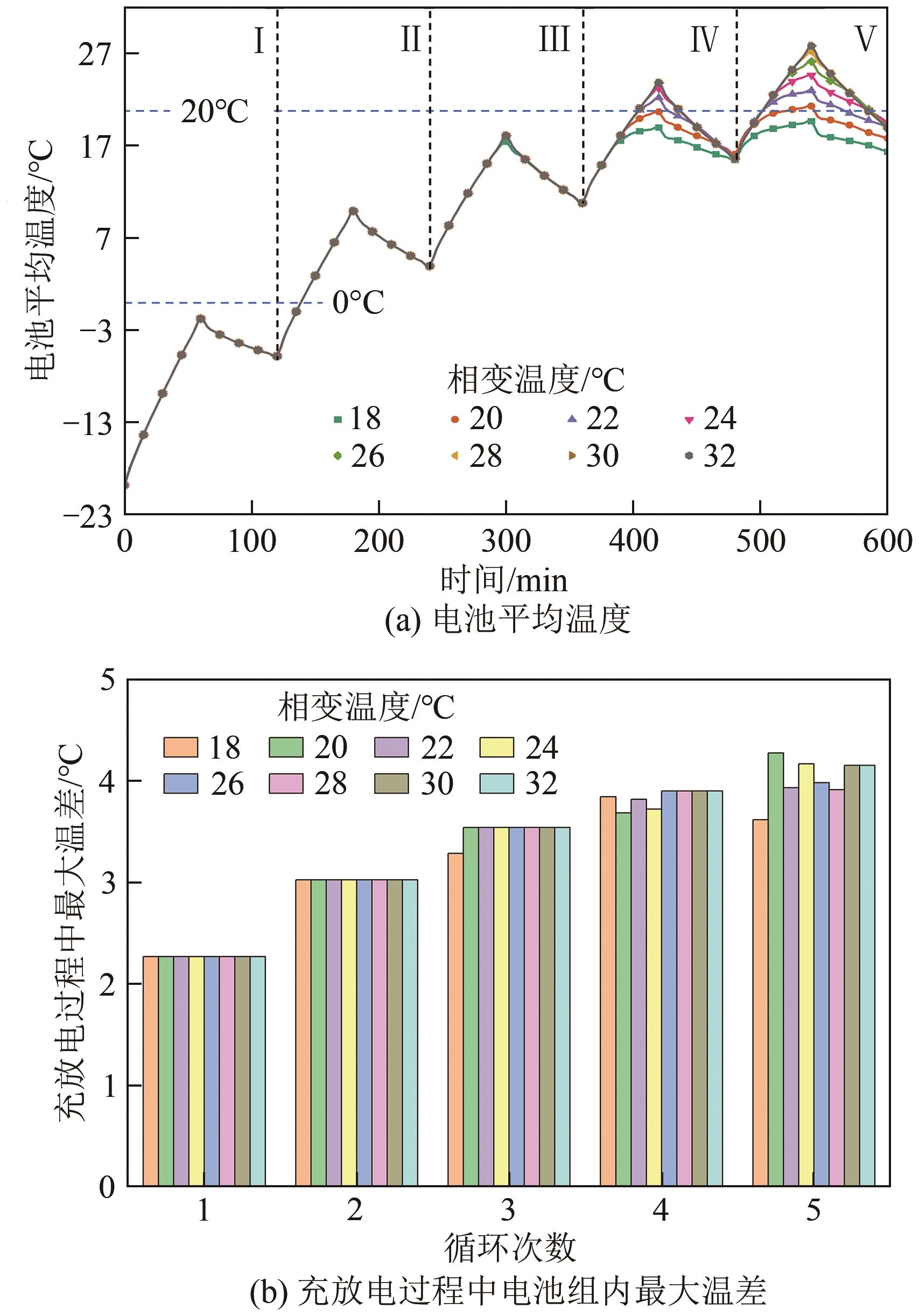Chemical Industry and Engineering Progress ›› 2024, Vol. 43 ›› Issue (8): 4333-4341.DOI: 10.16085/j.issn.1000-6613.2023-1185
• Energy processes and technology • Previous Articles
Analysis of thermal insulation characteristics of lithium-ion batteries based on phase change materials under low temperature
PAN Hanting( ), XU Hongtao(
), XU Hongtao( ), XU Duo, LUO Zhuqing
), XU Duo, LUO Zhuqing
- School of Energy and Power Engineering, University of Shanghai for Science and Technology, Shanghai 200093, China
-
Received:2023-07-11Revised:2023-08-22Online:2024-09-02Published:2024-08-15 -
Contact:XU Hongtao
低温条件下基于相变材料的锂离子电池保温特性分析
- 上海理工大学能源与动力工程学院,上海 200093
-
通讯作者:徐洪涛 -
作者简介:潘涵婷(1999—),女,硕士研究生,研究方向为电池热管理及相变储热。E-mail:1041580589@qq.com。 -
基金资助:上海市自然科学基金面上项目(20ZR1438700)
CLC Number:
Cite this article
PAN Hanting, XU Hongtao, XU Duo, LUO Zhuqing. Analysis of thermal insulation characteristics of lithium-ion batteries based on phase change materials under low temperature[J]. Chemical Industry and Engineering Progress, 2024, 43(8): 4333-4341.
潘涵婷, 徐洪涛, 许多, 罗祝清. 低温条件下基于相变材料的锂离子电池保温特性分析[J]. 化工进展, 2024, 43(8): 4333-4341.
share this article
Add to citation manager EndNote|Ris|BibTeX
URL: https://hgjz.cip.com.cn/EN/10.16085/j.issn.1000-6613.2023-1185
| 性能参数 | 数值 | 性能参数 | 数值 |
|---|---|---|---|
| 直径×高/mm | 18×65 | 标称容量/Ah | 2.9 |
| 密度/kg·m-3 | 2870 | 热导率/W·m-1·K-1 | 3 |
| 比热容/kJ·kg-1·K-1 | 0.7 | 适宜工作温度/℃ | 0~50 |
| 内阻/mΩ | 40 | 最佳工作温度/℃ | 20~45 |
| 性能参数 | 数值 | 性能参数 | 数值 |
|---|---|---|---|
| 直径×高/mm | 18×65 | 标称容量/Ah | 2.9 |
| 密度/kg·m-3 | 2870 | 热导率/W·m-1·K-1 | 3 |
| 比热容/kJ·kg-1·K-1 | 0.7 | 适宜工作温度/℃ | 0~50 |
| 内阻/mΩ | 40 | 最佳工作温度/℃ | 20~45 |
| 参数 | 聚氨酯保温材料 | 铝 | 石蜡 |
|---|---|---|---|
| 密度/kg·m-3 | 50 | 2719 | 770 |
| 比热容/J·kg-1·K-1 | 1460 | 871 | 2460 |
| 热导率/W·m-1·K-1 | 0.025 | 202.4 | 0.15 |
| 相变温度/℃ | 18~32 |
| 参数 | 聚氨酯保温材料 | 铝 | 石蜡 |
|---|---|---|---|
| 密度/kg·m-3 | 50 | 2719 | 770 |
| 比热容/J·kg-1·K-1 | 1460 | 871 | 2460 |
| 热导率/W·m-1·K-1 | 0.025 | 202.4 | 0.15 |
| 相变温度/℃ | 18~32 |
| 放电速率/C | 发热功率/W·m-3 |
|---|---|
| 0.5 | 6062.82 |
| 1.0 | 22294.63 |
| 2.0 | 85265.21 |
| 3.0 | 188911.75 |
| 放电速率/C | 发热功率/W·m-3 |
|---|---|
| 0.5 | 6062.82 |
| 1.0 | 22294.63 |
| 2.0 | 85265.21 |
| 3.0 | 188911.75 |
| 1 | WEI Chuanliang, ZHANG Yuchan, TIAN Yuan, et al. Design of safe, long-cycling and high-energy lithium metal anodes in all working conditions: Progress, challenges and perspectives[J]. Energy Storage Materials, 2021, 38: 157-189. |
| 2 | WANG Zichen, DU Changqing, QI Rui, et al. Experimental study on thermal management of lithium-ion battery with graphite powder based composite phase change materials covering the whole climatic range[J]. Applied Thermal Engineering, 2022, 216: 119072. |
| 3 | HU Xiaosong, ZHENG Yusheng, HOWEY David A, et al. Battery warm-up methodologies at subzero temperatures for automotive applications: Recent advances and perspectives[J]. Progress in Energy and Combustion Science, 2020, 77: 100806. |
| 4 | LEI Zhiguo, ZHANG Yuwen, LEI Xueguo. Improving temperature uniformity of a lithium-ion battery by intermittent heating method in cold climate[J]. International Journal of Heat and Mass Transfer, 2018, 121: 275-281. |
| 5 | LEI Zhiguo, ZHANG Chengning, LI Junqiu, et al. Preheating method of lithium-ion batteries in an electric vehicle[J]. Journal of Modern Power Systems and Clean Energy, 2015, 3(2): 289-296. |
| 6 | HE Fengqi, LI Xinxi, ZHANG Guoqing, et al. Experimental investigation of thermal management system for lithium ion batteries module with coupling effect by heat sheets and phase change materials[J]. International Journal of Energy Research, 2018, 42(10): 3279-3288. |
| 7 | BELGIBAYEVA Ayaulym, RAKHMETOVA Aiym, RAKHATKYZY Makpal, et al. Lithium-ion batteries for low-temperature applications: Limiting factors and solutions[J]. Journal of Power Sources, 2023, 557: 232550. |
| 8 | MA Xiaohang, CAO Xian, YE Yuanyuan, et al. Study on low-temperature performances of Nb16W5O55 anode for lithium-ion batteries[J]. Solid State Ionics, 2020, 353: 115376. |
| 9 | SYUM Zeru, BILLO Tadesse, SABBAH Amr, et al. Copper zinc tin sulfide anode materials for lithium-ion batteries at low temperature[J]. ACS Sustainable Chemistry & Engineering, 2021, 9(27): 8970-8979. |
| 10 | HALLAJ S AL, SELMAN J R. A novel thermal management system for electric vehicle batteries using phase-change material[J]. Journal of the Electrochemical Society, 2000, 147(9): 3231. |
| 11 | TIAN Dongbo, LIU Weijun, ZHANG Shuhua, et al. Simulation of a set of lithium-ion batteries with composite phase change materials and heating films thermal management system at low temperature[J]. Journal of Thermal Science and Engineering Applications, 2021, 13(1): 011002. |
| 12 | SUN Mingyang, LIU Tong, LI Mulin, et al. A deep supercooling eutectic phase change material for low-temperature battery thermal management[J]. Journal of Energy Storage, 2022, 50: 104240. |
| 13 | PEREIRA DA CUNHA Jose, EAMES Philip. Thermal energy storage for low and medium temperature applications using phase change materials—A review[J]. Applied Energy, 2016, 177: 227-238. |
| 14 | 温小燕, 凌子夜, 方晓明, 等. RT28/气相二氧化硅复合相变材料的制备及对锂离子电池的保温性能研究[J]. 高校化学工程学报, 2016, 30(5): 1178-1183. |
| WEN Xiaoyan, LING Ziye, FANG Xiaoming, et al. Preparation of RT28/hydrophobic-fumed-silica composite phase change materials and their thermal insulation application in lithium ion battery[J]. Journal of Chemical Engineering of Chinese Universities, 2016, 30(5): 1178-1183. | |
| 15 | LUO Mingyun, LIN Xuemin, FENG Jinxin, et al. Fast self-preheating system and energy conversion model for lithium-ion batteries under low-temperature conditions[J]. Journal of Power Sources, 2023, 565: 232897. |
| 16 | HUO Yutao, RAO Zhonghao. Investigation of phase change material based battery thermal management at cold temperature using lattice Boltzmann method[J]. Energy Conversion and Management, 2017, 133: 204-215. |
| 17 | HE Sihong, XIONG Binyu, LEI Han, et al. Optimization of low-temperature preheating strategy for Li-ion batteries with supercooling phase change materials using response surface method[J]. International Communications in Heat and Mass Transfer, 2023, 142: 106635. |
| 18 | 罗明昀, 凌子夜, 方晓明, 等. 基于相变储热技术的电池热管理系统研究进展[J]. 化工进展, 2022, 41(3): 1594-1607. |
| LUO Mingyun, LING Ziye, FANG Xiaoming, et al. Research progress of battery thermal management system based on phase change heat storage technology[J]. Chemical Industry and Engineering Progress, 2022, 41(3): 1594-1607. | |
| 19 | LI Zhuoming, LIANG Zhixuan, WANG Changhong, et al. Optimization of heat transfer and temperature control of battery thermal management system based on composite phase change materials[J]. Surfaces and Interfaces, 2023, 36: 102621. |
| 20 | WANG Shuping, ZHANG Danfeng, LI Changhao, et al. Numerical optimization for a phase change material based lithium-ion battery thermal management system[J]. Applied Thermal Engineering, 2023, 222: 119839. |
| 21 | SUDHAKARAN Sourav, TERESE Maria, MOHAN Yedhu, et al. Influence of various parameters on the cooling performance of battery thermal management systems based on phase change materials[J]. Applied Thermal Engineering, 2023, 222: 119936. |
| 22 | LIU Zhenwei, WANG Boyuan, TAN Youwei, et al. Thermal management of lithium-ion battery pack under demanding conditions and long operating cycles using fin-enhanced PCMs/water hybrid cooling system[J]. Applied Thermal Engineering, 2023, 233: 121214. |
| 23 | 冯能莲, 马瑞锦, 陈龙科. 18650型锂离子动力电池热特性研究[J]. 电源技术, 2019, 43(4): 564-567. |
| FENG Nenglian, MA Ruijin, CHEN Longke. Research on thermal characteristics of 18650 lithium-ion power battery[J]. Chinese Journal of Power Sources, 2019, 43(4): 564-567. | |
| 24 | ZHANG Chuanwei, XIA Zhan, WANG Bin, et al. A Li-ion battery thermal management system combining a heat pipe and thermoelectric cooler[J]. Energies, 2020, 13(4): 841. |
| 25 | LI Dinggen, YU Zihao. Natural convection melting in a cubic cavity with internal fins: A lattice Boltzmann study[J]. Case Studies in Thermal Engineering, 2021, 25: 100919. |
| 26 | 王峰, 李茂德. 电池热效应分析[J]. 电源技术, 2010, 34(3): 288-291. |
| WANG Feng, LI Maode. Thermal performance analysis of batteries[J]. Chinese Journal of Power Sources, 2010, 34(3): 288-291. | |
| 27 | BERNARDI D, PAWLIKOWSKI E, NEWMAN J. A general energy balance for battery systems[J]. Journal of the Electrochemical Society, 1985, 132(1): 5-12. |
| 28 | PESARAN A, KEYSER M, BURCH S. An approach for designing thermal management systems for electric and hybrid vehicle battery packs[C]//The Fourth Vehicle Thermal Management Systems Conference and Exhibition, 1999. |
| 29 | XU Duo, QU Zhiguo, AN Lu, et al. Pore-scale study on the effects of randomly distributed void cavities on the thermal performance of composite phase change materials[J]. Journal of Energy Storage, 2022, 55: 105715. |
| [1] | MA Yongli, LI Muyang, MA Zihao, WANG Haoran, WANG Maolong, FEI Yaohan, ZHANG Lubin, LIU Mingyan. Experiment of simulation study on gas-solid fluidization on Martian environments [J]. Chemical Industry and Engineering Progress, 2024, 43(8): 4203-4209. |
| [2] | JIANG Jingzhi, SHAO Guowei, CUI Haiting, LI Hongtao, YANG Qi. Analysis of enhanced heat transfer characteristics of finned triplex-tube phase change heat storage unit [J]. Chemical Industry and Engineering Progress, 2024, 43(8): 4210-4221. |
| [3] | ZHAO Weigang, ZHANG Qianqian, LAN Yuling, YAN Wen, ZHOU Xiaojian, FAN Mizi, DU Guanben. Research progress and prospect of the core materials for vacuum insulation panel [J]. Chemical Industry and Engineering Progress, 2024, 43(7): 3910-3922. |
| [4] | WANG Qingtai, ZHANG Sai, WANG Jiemin. Numerical simulation for non-uniform compression of porous electrodes in vanadium flow batteries [J]. Chemical Industry and Engineering Progress, 2024, 43(6): 2940-2949. |
| [5] | HE Ruiqiang, FANG Min, ZHOU Jianduo, FEI Hua, YANG Kai. Research progress of TPE-based flexible composite phase change materials for thermal management of lithium batteries [J]. Chemical Industry and Engineering Progress, 2024, 43(6): 3159-3173. |
| [6] | TIAN Xiaodie, HE Zhaoyu, ZHANG Peng. Preperation of an intelligent thermo-regulatory textile with hydrophobic surface and its performance study [J]. Chemical Industry and Engineering Progress, 2024, 43(6): 3247-3255. |
| [7] | LIANG Ximei, FEI Hua, LI Yuanlin, YONG Fan, GUO Mengqian, ZHOU Jiahong. Preparation and thermal properties of lauric acid-based binary low compatible energy storage materials [J]. Chemical Industry and Engineering Progress, 2024, 43(6): 3256-3267. |
| [8] | SUN Xian, LIU Jun, WANG Xiaohui, SUN Changyu, CHEN Guangjin. Review of experimental and numerical simulation research on the development of natural gas hydrate reservoir with underlying gas [J]. Chemical Industry and Engineering Progress, 2024, 43(4): 2091-2103. |
| [9] | DU Yongliang, LIANG Zhuobin, GONG Yaoxu, BI Haojie, XU Zhiyuan, YUAN Hongying. Air gap membrane distillation research status and applications [J]. Chemical Industry and Engineering Progress, 2024, 43(4): 1655-1666. |
| [10] | SUN Chao, AI Shiqin, LIU Yuechan. Numerical simulation plate side flow heat transfer new plate-shell heat exchanger with considering physical property changes and shell heat transfer [J]. Chemical Industry and Engineering Progress, 2024, 43(4): 1676-1689. |
| [11] | ZHU Yanni, WANG Wei, SUN Yanchenhao, WEI Gang, ZHANG Dawei. Numerical simulation of centrifugal spray drying based on single-droplet evaporation [J]. Chemical Industry and Engineering Progress, 2024, 43(4): 1700-1710. |
| [12] | ZHAO Jilong, GUO Yuxiang, CHEN Hongxia, YUAN Dazhong, DU Xiaoze. Experimental and numerical simulation on heat transfer characteristics of vertical cesium heat pipes [J]. Chemical Industry and Engineering Progress, 2024, 43(4): 1711-1719. |
| [13] | DING Lihua, XU Hongtao, ZHANG Chenyu. Analysis of the heat storage performance of the latent heat storage unit combined with frustum wavy tube [J]. Chemical Industry and Engineering Progress, 2024, 43(3): 1214-1223. |
| [14] | YU Yanfang, DING Pengcheng, MENG Huibo, SHI Bowen, YAO Yunjuan. Heat transfer enhancement of non-Newtonian fluid in the blade-type static mixer [J]. Chemical Industry and Engineering Progress, 2024, 43(3): 1145-1156. |
| [15] | YIN Shaowu, LI Xianxian, HAN Jiawei, LU Ming, TONG Lige, WANG Li. Heat charge and release characteristics of household off-peak electricity thermal storage heating system [J]. Chemical Industry and Engineering Progress, 2024, 43(3): 1206-1213. |
| Viewed | ||||||
|
Full text |
|
|||||
|
Abstract |
|
|||||

